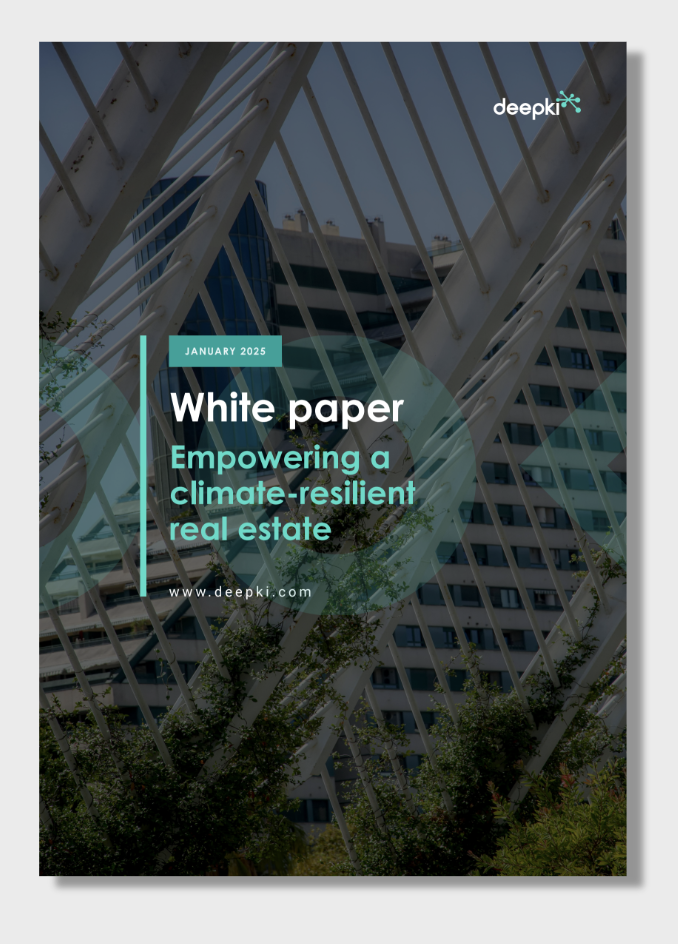As climate-related risks intensify for real estate assets, banks must adapt to a constantly evolving landscape of loan performance and credit exposure. Yet, with only 9% of real estate debt labeled as sustainable over the past five years, many lenders may be underestimating the financial risks linked to unsustainable assets.
For banks, this is more than a sustainability concern. It’s a critical issue of credit risk and loan optimization. The risks and the cost of inaction should not be underestimated. It’s crucial for banks to proactively assess and mitigate risks tied to the real estate assets they finance.
This blog will explore how banks can reduce credit risk and enhance loan profitability by incorporating sustainable finance strategies. These strategies include green loans, key performance indicators (KPIs) to assess environmental impact, and the tracking of climate-related risks. By doing so, banks can improve loan outcomes, enhance financial performance, and align with the sector’s evolving demands.
The cost of climate risk
Buildings that aren’t sustainable are rapidly becoming unfinanceable. From regulatory enforcement to insurance premium increases, these assets are losing their financial viability. For financial institutions, investing in non-sustainable buildings carries a high credit risk. Why? Because the probability of a financial loss due to a borrower’s default is greater for properties that lack green certifications.
Meanwhile, assets aligned with climate goals, such as energy-efficient or certified green buildings, are proving to be not only lower-risk but also more profitable. By overlooking sustainability, financial institutions expose themselves to multiple layers of risks:
- Higher insurance premiums for vulnerable or outdated buildings. For instance, across the United States, commercial real estate premiums have increased over 88% over the last five years, according to JLL.
- Lower resale value in case of default. Studies comparing certified and non-certified buildings within the same submarkets have found that higher certification levels, such as LEED or Green Star, were linked to greater sales premiums.
- Increased exposure to regulatory pressure, such as mandatory energy retrofitting or carbon pricing policies.
- Rising vacancy rates: unoccupied or underutilized assets are a red flag for lenders because they directly impact rental income. For instance, in Paris La Défense business district, as of late 2024, office vacancy hovered around 15%, with older buildings being especially difficult to lease without retrofit plans.

Empowering a climate-resilient real estate
Download our white paper to learn more about the holistic approach to climate risk and practical strategies for building resilience
The opportunity: unlocking green finance in real estate
Banks can leverage a wide range of financial instruments and strategies to drive environmental performance. These instruments include regulatory frameworks, risk management practices or green loans. Today, integrating these tools into a comprehensive strategy is no longer a “nice-to-have” for banks; they are pathways to economic growth.
10 ways in which sustainable finance impacts the real estate sector
Green loans as a key driver for banks
Green loans serve as a strategic instrument for banks to address climate risks while improving their financial performance. Allocating their capital to projects with environmental impacts, such as green buildings, renewable energy installations, and energy-efficient retrofits, allows banks to reduce their credit risk.
As first formalized in 2018 under the Green Loan Principles (GLP), green loans are “any type of loan instruments and/or contingent facilities where the proceeds or an equivalent amount shall be exclusively applied to finance, re-finance or guarantee, in whole or in part, new and/or existing eligible Green Projects and which are aligned to the four core components of the GLP.”
Green loans prove to be powerful tools, safeguarding banks against downside risks while unlocking upside opportunities for them in the transition to a low-carbon economy.
Why invest in green buildings?
Credit risk reduction
As highlighted in a May 2024 report from the UNEP Finance Initiative and the UN, there is a strong business case for investing in green buildings. Financing green-certified buildings enables banks to reduce financial risk. On the other, it improves the quality and resilience of their loan books, making it a strategic choice:
- Lower borrower risk: green buildings are associated with higher tenant satisfaction, lower turnover, and reduced vacancy risk. This also stabilizes income and reduces default probability.
- Lower utility costs: the average green building saves around 25% more energy and uses 11% less water than a regular building. This reduces tenants’ operational costs and improves debt-service ratios.
- Lower transition risk: green assets are more likely to meet evolving environmental standards. Moreover, it helps reduce exposure to policy changes, costly retrofits, or regulatory penalties.
- More stable collateral: these buildings often retain higher market value and are better equipped to withstand climate risks, which maximizes their position as loan security.
Financial benefits
Green buildings have become a strong financial asset, offering better returns and lower risk. As investor demand for green assets continues to rise, financing certified green buildings enables banks to attract growing sustainable investment capital.
Moreover, investing in green buildings through green loans provides banks with an alternative funding option. They can be refinanced through green bonds, allowing banks to secure lower interest rates and more favorable pricing. Additionally, green loans can enhance a bank’s eligibility for support from public financial institutions such as the European Investment Bank or national green banks.
Finally, financing sustainable assets enables banks to remain compliant with evolving regulations, fostering long-term trust with investors, regulators, and borrowers.
Learn more: The impact of ESG performance on real estate asset value
Key KPIs banks should track to scale green lending
To seize these opportunities and scale green finance effectively, banks need clear, measurable indicators. Here are the key performance metrics they can track:
Core environmental performance
Reflects exposure to transition/physical risks per loan/project.
Exposure to climate-related physical risks (e.g., floods and extreme weather) is another way to ensure that asset value will be maintained in the long run.
CRREM decarbonization pathways help banks identify when and how financed buildings risk becoming “stranded” (i.e., non-compliant with emission thresholds), based on current performance and retrofit plans.
Tracking the percentage of improvement in a building’s energy performance directly reflects operational savings and is a key metric under both green loan frameworks and regulatory disclosures.
Measuring the reduction of GHG emissions resulting from the financed project helps banks quantify the environmental impact of their lending and align with climate targets.
A regulatory KPI under the EU Taxonomy that indicates the proportion of a bank’s assets aligned with environmental objectives. Critical for Pillar III disclosures and investor transparency.
Frameworks & reporting standards
These guidelines help stress-test loan books and qualify loans as “green” under-recognized frameworks.
It defines clear, science-based criteria to determine whether economic activities, like green buildings, are environmentally sustainable and eligible for green financing.
It provides a framework for banks to assess and disclose how climate-related risks and opportunities impact their lending portfolios and financial planning
Under ICMA GLP principles, credible green loans must follow four components: use of proceeds, evaluation process, management of proceeds, and impact reporting, all of which hinge on reliable KPIs.
PCAF is a global initiative that aims to help financial institutions measure and disclose the greenhouse gas (GHG) emissions associated with their lending and investing.
Transparent KPIs tracking builds investor trust, supports regulatory compliance, and strengthens loan book quality.
What is holding the sector back?
Limited visibility and data gaps
Banks need to obtain information on the assets they are financing through loans. Why? Because in the event of the debtor’s default, they will reclaim the assets. To reduce this credit risk, banks must assess some physical and transitional climate-related risks associated with the underlying asset. A 2024 Deloitte report highlights this, estimating that U.S. banks have over $1.7 trillion of exposure to sectors vulnerable to natural capital loss, with real estate one of the most exposed.
However, despite the growing case for green real estate lending, many banks still struggle to turn ambition into effective action. Despite growing investor demand and regulatory pressure, different barriers continue to slow progress. This is especially relevant when dealing with Small and Medium Enterprises (SMEs) or assets in Emerging Markets (EMs).
- SMEs often lack the tools, resources, or incentives to track and report environmental performance.
- EMs face inconsistent building standards, a lack of digital infrastructure, and limited access to certified energy auditors or green building consultants.
As a result, banks make financing decisions without complete or reliable data. Without trusted baseline data, banks either overestimate risks, resulting in missed opportunities, or underestimate them, exposing themselves to climate-related defaults.
Internal silos and lack of system integration
But even when data and taxonomy alignment are in place, many banks face critical internal integration challenges. Sustainability remained too often siloed, managed by separate teams using isolated tools. This leaves little to no connection with core systems such as credit risk models, loan origination, or portfolio stress testing.
As a result, climate-related risks are not integrated into real-time lending decisions or automated credit scoring, leaving banks vulnerable to blind spots in risk assessment. In the worst cases, sustainability reporting becomes a technical exercise, entirely disconnected from actual financial performance or credit exposure. This puts institutions at serious risk of regulatory non-compliance and mis-priced lending.
Regulatory misalignment: a growing financial risk
What qualifies as a green building in one country may not be recognized as such in another. The absence of a globally unified standard creates regulatory fragmentation. Some governments have mandatory disclosure frameworks, such as the EU with the SFDR, while others rely on voluntary or outdated guidelines. This patchwork of standards makes it difficult for banks to harmonize their credit models across portfolios or regions, complicating compliance, impact measurement, and investor reporting.
Bridging the climate financing gap: seizing the opportunity
Manage the financed emissions of real estate assets
As financial institutions face mounting regulatory scrutiny and rising expectations from investors, one of the most pressing challenges is gaining visibility over the environmental performance of the real estate assets they finance.
Deepki for Finance empowers lenders to assess, manage, and disclose the financed emissions of their real estate loan portfolios.
- Data visibility: Seamlessly collect and centralize building performance data from any asset, with a simple address. Deepki engages asset owners to improve data quality, while AI-powered estimations fill data gaps to ensure complete coverage.
- Risk scoring: Enhance climate risk models and PCAF scoring with real, asset-level data. Identify credit risks linked to physical and transition exposures and better evaluate collateral resilience over time.
- Reporting: Generate tailored reports at any granularity, by fund, country, asset class, or timeframe. Align with frameworks like GAR, EU Taxonomy, CSRD, and TCFD to meet both compliance and voluntary reporting needs.
- Forward planning: Project decarbonization pathways for financed assets. Assess borrower plans, simulate retrofit needs, and identify where financial institutions can reduce future credit exposure while contributing to climate targets.
- Strategy adaptation: Use a reliable set of insights to adjust lending strategies. Prioritize low-risk, high-performing assets and allocate capital toward sustainable investments based on building quality, decarbonization potential, and compliance readiness.
With Deepki for Finance, financial institutions transform data into insights and insights into action, across the full lifecycle of real estate financing.
Green finance is no longer seen as small-scale. Instead, it’s becoming a credit quality signal, a profitability driver, and a requirement to operate in tomorrow’s financial system.
For banks, the challenge is not whether they should finance green portfolios; it’s whether they are moving fast enough to assess and price climate risk correctly, to seize the opportunity. In today’s new lending environment, less sustainability doesn’t only mean more profit, it means higher risk.

WHITE PAPER
Rethinking real estate investment: turning sustainable performance into competitive returns
Deepki’s new white paper is dedicated to helping decision-makers confront the disconnect between climate ambition and financial execution.
Download the white paper and discover what data, reporting, and planning frameworks earn investor trust, why aligning financial and sustainability goals unlocks better capital access and how retrofit strategies can be structured to support financial decision-making!


